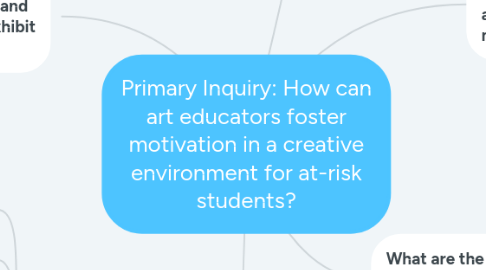Primary Inquiry: How can art educators foster motivation in a creative environment for at-risk students?
by khaila piorecky


1. How can art educators improve engagement and project success for at-risk students who are demonstrating defiant behaviours through choice-oriented instruction?
1.1. ODD students and PTSD - art as a way of dealing with stress
1.2. Look at other district alternative ed art programs and examine behaviour and classroom management strategies
1.3. Does choice take too much time for these students?
1.3.1. Student surveys beginning semester and et end of semester
1.3.1.1. Ask about engagement, motivation and self-esteem. How they felt about project success and learning.
1.4. How does the traditional model of teaching art affect students? At-risk students?
2. What role can design-thinking play in fostering motivation and success for students who exhibit challenging behaviours?
2.1. Choice-oriented activities promote ownership of experiences and encourage students to take initiative in the learning process
2.1.1. Dahlheimer
2.1.2. TAB/ APR/ DBAE/ VCAE
3. Resources to include
3.1. Art ed classroom management strategies
3.2. General guiding principles of choice and learner-centered pedagogy
3.3. resources that support traditional, teacher-led activities
3.4. Tips and tricks from other alternative ed schools
3.5. At-risk student learning needs
3.6. DBAE and VCAE compared to Choice
3.7. Strategies in working with at-risk students
3.8. Safe environments in the art room
4. What challenges do art educators face when guiding at-risk students to create meaningful works of art?
4.1. Behaviour plans and interventions/ IEPs and support connections with learning assistance teams and counselor
4.2. What role does relationship/ connection with the teacher play with student output and learning success?
4.3. Reach out to FB teachers groups and other social media platforms to ask about specific challenges/ tips/ tricks
4.3.1. Are the challenges associated with motivation and learning success in the art room shared by all teachers, or are these challenges shared more commonly with teachers involved with at-risk students?
5. What are the best classroom strategies to motivate at-risk students to create works of art?
5.1. How can art educators structure their curriculum plans to best motivate and foster creative environments for students based on:
5.1.1. Time of year
5.1.2. IEP/ learning needs/ behaviour designations/ trauma and psychological support
5.1.3. individual learning desires and passions
5.2. classroom management strategies and studio ownership
5.3. collaboration vs independent studies
5.4. Although every class and its' needs will be different, what are some practical PRINCIPLES art educators can be guided by
5.4.1. Traditional teacher-directed in combination with student/ learner-centred
